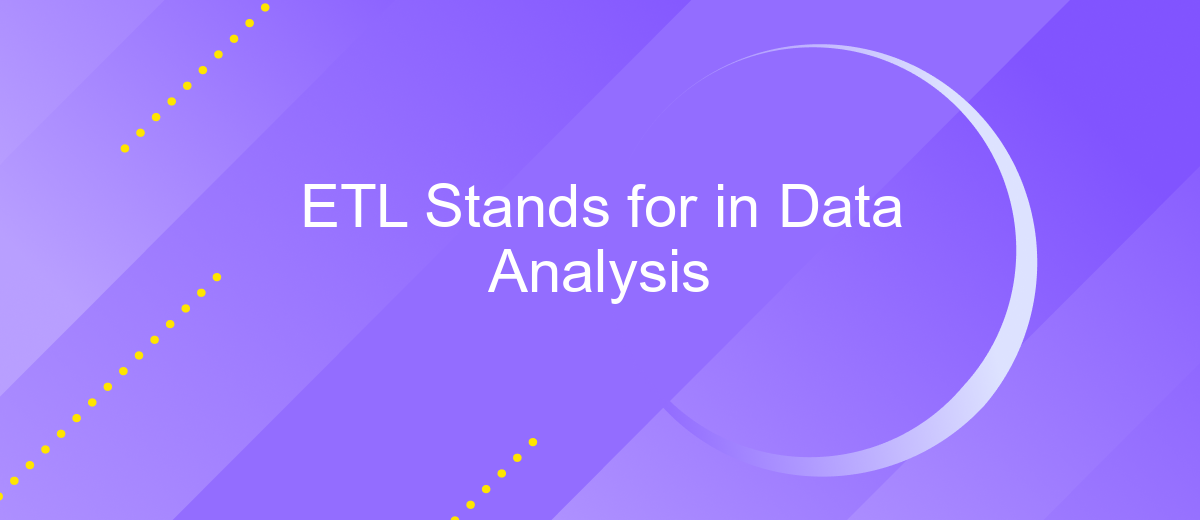ETL Stands for in Data Analysis
ETL, which stands for Extract, Transform, Load, is a fundamental process in data analysis. It involves extracting data from various sources, transforming it into a suitable format, and loading it into a destination database or data warehouse. This process ensures that data is accurate, consistent, and ready for analysis, making ETL a critical component in the data management lifecycle.
Extract
In the ETL process, the "Extract" phase involves retrieving data from various source systems. This step is crucial as it lays the foundation for the subsequent transformation and loading stages. During extraction, data is collected from multiple sources such as databases, cloud services, and applications.
- Identify data sources: Determine where the data resides, whether in relational databases, NoSQL databases, or cloud storage.
- Data extraction methods: Choose the appropriate method for data retrieval, such as full extraction, incremental extraction, or real-time extraction.
- Ensure data quality: Validate and clean the data to ensure it is accurate and complete before moving to the next phase.
Tools like ApiX-Drive can simplify the extraction process by providing seamless integrations with various data sources. ApiX-Drive allows users to automate data extraction, reducing manual effort and minimizing errors. By leveraging such tools, organizations can ensure a consistent and reliable data extraction process, setting the stage for effective data transformation and loading.
Transform

The transformation phase in ETL (Extract, Transform, Load) is crucial for converting raw data into a format suitable for analysis. This step involves cleaning, filtering, and structuring the data to ensure it meets the requirements of the target database or data warehouse. Techniques such as data normalization, aggregation, and enrichment are employed to enhance data quality and consistency. Transformation also entails the application of business rules and logic to the data, ensuring that it aligns with organizational standards and objectives.
Moreover, modern ETL processes often leverage specialized tools and services to streamline the transformation phase. For instance, ApiX-Drive offers powerful integration capabilities that can automate the transformation of data between various platforms. By utilizing such services, organizations can significantly reduce manual intervention, minimize errors, and accelerate the overall ETL process. ApiX-Drive enables seamless data mapping and transformation, ensuring that the data is accurately prepared for subsequent loading and analysis stages, thereby enhancing the efficiency and reliability of data workflows.
Load

The final step in the ETL process is the Load phase, where the transformed data is loaded into the target data repository. This repository can be a data warehouse, a data lake, or any other storage system designed to handle large volumes of data. The goal is to ensure that the data is accessible, reliable, and ready for analysis or reporting.
- Determine the target system: Identify whether the data will be loaded into a data warehouse, data lake, or another storage system.
- Choose the loading method: Decide between batch loading or real-time loading, depending on the use case and data requirements.
- Map the data: Ensure that the data fields from the transformed dataset match the schema of the target system.
- Execute the load: Use ETL tools or integration services like ApiX-Drive to automate and manage the data loading process.
- Verify data integrity: Perform checks to confirm that the data has been accurately loaded and is complete.
Using integration services like ApiX-Drive can simplify the Load phase by providing automated workflows and real-time data synchronization. This ensures that the data is consistently updated and available for analysis, reducing the risk of errors and improving overall efficiency.
Data Integration

Data integration is a critical component of data analysis, enabling seamless access and management of data from various sources. It involves combining data from different systems and formats to provide a unified view, which is essential for making informed business decisions.
Effective data integration ensures that data is accurate, consistent, and readily available for analysis. This process typically includes data extraction, transformation, and loading (ETL), which prepares the data for use in analytics and reporting tools.
- Extraction: Gathering data from multiple sources.
- Transformation: Converting data into a consistent format.
- Loading: Importing the transformed data into a database or data warehouse.
Tools like ApiX-Drive simplify the integration process by automating data transfers between various platforms and applications. With its user-friendly interface and customizable workflows, ApiX-Drive allows businesses to streamline data integration, reducing the time and effort required to maintain data consistency across different systems.
- Automate the work of an online store or landing
- Empower through integration
- Don't spend money on programmers and integrators
- Save time by automating routine tasks
Data Transformation
Data transformation is a crucial step in the ETL process, where raw data is converted into a more suitable format for analysis. This involves various operations such as filtering, sorting, aggregating, and enriching the data. The goal is to ensure that the data is clean, consistent, and ready for analysis. During this phase, data might be standardized to a common format, missing values might be handled, and irrelevant information might be removed.
One of the key aspects of data transformation is ensuring seamless integration between different data sources. Tools like ApiX-Drive can be instrumental in this process. ApiX-Drive allows for easy setup of integrations between various services, automating the flow of data from one platform to another. This not only saves time but also reduces the risk of errors during data transfer. By using such tools, businesses can ensure that their data transformation processes are efficient and reliable, paving the way for more accurate and insightful data analysis.
FAQ
What does ETL stand for in data analysis?
Why is ETL important in data analysis?
What are the main steps involved in the ETL process?
How can ETL processes be automated?
What are some common challenges faced during ETL implementation?
Apix-Drive will help optimize business processes, save you from a lot of routine tasks and unnecessary costs for automation, attracting additional specialists. Try setting up a free test connection with ApiX-Drive and see for yourself. Now you have to think about where to invest the freed time and money!


